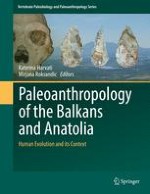2016 | OriginalPaper | Chapter
15. The Plio-Pleistocene Large Mammal Record of Greece: Implications for Early Human Dispersals into Europe
Authors : George D. Koufos, Dimitris S. Kostopoulos
Published in: Paleoanthropology of the Balkans and Anatolia
Publisher: Springer Netherlands
Activate our intelligent search to find suitable subject content or patents.
Select sections of text to find matching patents with Artificial Intelligence. powered by
Select sections of text to find additional relevant content using AI-assisted search. powered by
